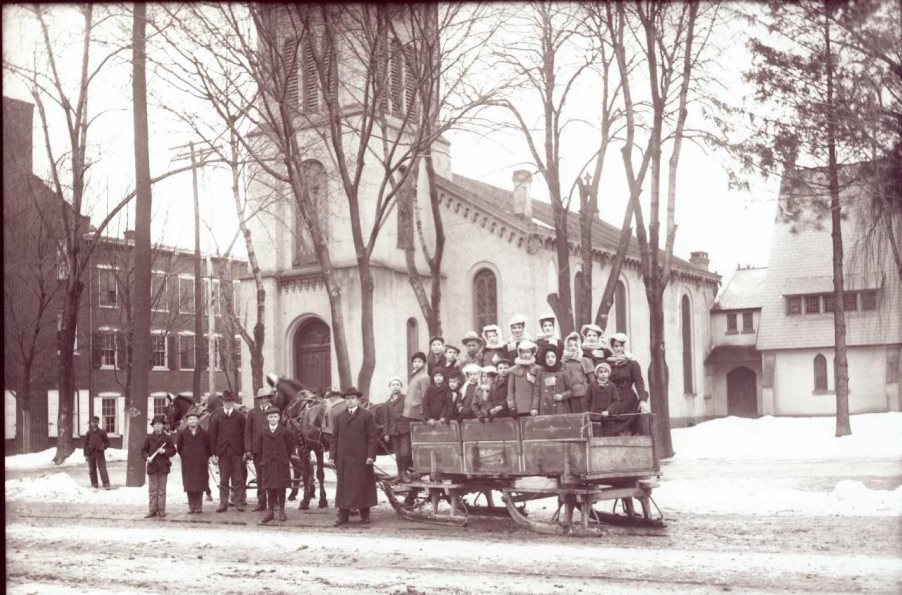Sons of the American Revolution
The National Society of the Sons of the American Revolution was founded in 1889. One of the first meetings of the SAR took place in the historic Long Room of Fraunces Tavern in New York City.

Sleighing group, probably a school group in front of St. John's Episcopal Church around 1910 (00147A).
In 1751 Carlisle was selected as the county-seat for Cumberland County. The town’s square was eventually divided into four quadrants: south-east (stone quarry /Market House), south-west (Court House), north-west (Presbyterian Church), north-east (Church of England). One year later an evening prayer service for the Established Church took place in a log cabin located on the north-east corner of the square.1 The structure served as temporary quarters for the county courthouse until one was constructed on the south-west corner of the square in 1764. The Church of England also known as the Established Church had sent missionaries to its colonies through the Society of the Propagation of the Gospel in Foreign Parts (SPG).2 The SPG was under the direct control of the Bishop of London. During the colonial period Lancaster City’s English Church served as the home base for the circuit that included: Carlisle, York Springs (Huntington) and York. Carlisle was the smallest congregation of the three; in 1752 the Reverend Mr. George Craig reported that there were about eighteen families. Cumberland County was sparsely populated and the vast majority of the settlers were Presbyterians.
A small stone structure was started in 1762 and completed in 1767 that would replace the log building on the north-east corner of the square. William Thomson (1735-1785) a local native and newly ordained priest served the circuit during this period. His father Samuel Thompson (1685-1785) had been the first residential pastor at Meeting House Springs Presbyterian Church (1739-1749) located one mile west of Carlisle.3 Parson William wrote to the SPG about the dire living conditions of his Central Pennsylvania parishioners during the French and Indian War years.4
The Revolutionary War period (1774-1784) was a very difficult time for the English Church. In the church’s liturgy it is an obligation of the clergy to pray for the country’s leader. For example prior to King Henry VIII (reign 1507–1547) the pope was prayed for, after Henry VIII the (English) sovereign was prayed for, today (in the United States) the president is prayed. As a result the local community who was supporting independence from England could not understand nor tolerate a church that was praying for its enemy. The full brunt of this opposition fell on Daniel Batewell a newly arrived (from England) pastor who was appointed to the circuit in 1774. At first he was well received at the three congregations but when he refused to change his liturgical customs and vocally supported the loyalists his life became very precarious. The Carlisle and York churches were closed and the York Springs Church was slightly safer due to the fact that many of his neighbors were Quaker farmers who remained neutral and would sell him food for his family.5
With the close of the war and the American independence won, the Church of England allowed the Americans to have their own bishops and a new independent church was formed called the Protestant Episcopal Church of the United States (1789). The SPG was no longer involved with the American colonies and each church became self-supporting. Also the churches developed a distinct name: Carlisle, Saint John (the Evangelist); York, Saint John (the Baptist); York Springs, Christ Church. Surprisingly the circuit was still intact in 1784 when a new pastor arrived from England, John Campbell (1749-1819) another native person.6 Born near Shippensburg he was the son of an early fur trader, Francis Campbell. Campbell had a strong academic background as a Princeton graduate who studied in England where he was ordained to the priesthood in 1773. Carlisle’s membership grew considerably but Campbell did not involve the parish with the new American church hierarchy nor the old Church of England hierarchy. St. John’s steered an independent path for the next thirty-five years.7 In1826 the old stone edifice was replaced by a much larger structure that still functions today.
The National Society of the Sons of the American Revolution was founded in 1889. One of the first meetings of the SAR took place in the historic Long Room of Fraunces Tavern in New York City.
1 Charles Gilbert Beetem, Colonial Carlisle, (Carlisle: Hanilton Library and Historical Association of Cumberland County, 1958) p. 6.
2 Bonnell Spencer, O.H.C., Ye Are the Body: A People’s History of the Church, (West Park, New York: Holy Cross Publications, 1965) p 226.
3 Richard L.Tritt, Here Lyes the Body: The Story of Meeting House Springs, (Carlisle: First Presbyterian Church) p 15.
4 Emeline Knox Parker, “Life of Reverend William Thomson” Unpublished paper dated March 19, 1936, Archives Collection, CCHS.
5 James P. Myers, Jr, editor, Adams County History, “The Bermudian Creek Tories”, 1998, p. 30.
6 The Spire on the Square: A History St. John’s Episcopal Church, Carlisle, PA, 1752-2002, (Carlisle: Rector and Wardens of St. John’s Episcopal Church, 2002) p. 23.
7 Ibid., p. 27.